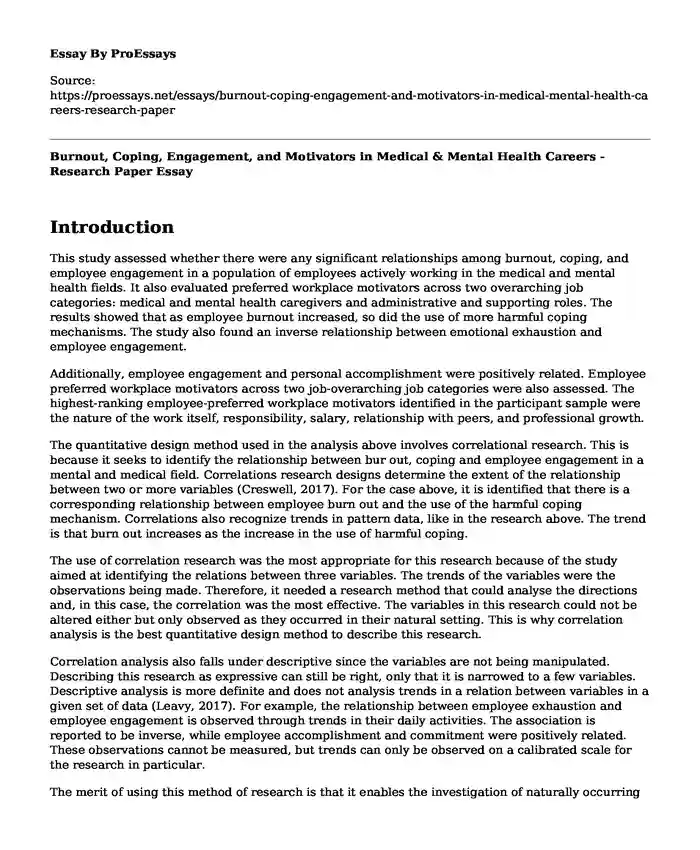Introduction
This study assessed whether there were any significant relationships among burnout, coping, and employee engagement in a population of employees actively working in the medical and mental health fields. It also evaluated preferred workplace motivators across two overarching job categories: medical and mental health caregivers and administrative and supporting roles. The results showed that as employee burnout increased, so did the use of more harmful coping mechanisms. The study also found an inverse relationship between emotional exhaustion and employee engagement.
Additionally, employee engagement and personal accomplishment were positively related. Employee preferred workplace motivators across two job-overarching job categories were also assessed. The highest-ranking employee-preferred workplace motivators identified in the participant sample were the nature of the work itself, responsibility, salary, relationship with peers, and professional growth.
The quantitative design method used in the analysis above involves correlational research. This is because it seeks to identify the relationship between bur out, coping and employee engagement in a mental and medical field. Correlations research designs determine the extent of the relationship between two or more variables (Creswell, 2017). For the case above, it is identified that there is a corresponding relationship between employee burn out and the use of the harmful coping mechanism. Correlations also recognize trends in pattern data, like in the research above. The trend is that burn out increases as the increase in the use of harmful coping.
The use of correlation research was the most appropriate for this research because of the study aimed at identifying the relations between three variables. The trends of the variables were the observations being made. Therefore, it needed a research method that could analyse the directions and, in this case, the correlation was the most effective. The variables in this research could not be altered either but only observed as they occurred in their natural setting. This is why correlation analysis is the best quantitative design method to describe this research.
Correlation analysis also falls under descriptive since the variables are not being manipulated. Describing this research as expressive can still be right, only that it is narrowed to a few variables. Descriptive analysis is more definite and does not analysis trends in a relation between variables in a given set of data (Leavy, 2017). For example, the relationship between employee exhaustion and employee engagement is observed through trends in their daily activities. The association is reported to be inverse, while employee accomplishment and commitment were positively related. These observations cannot be measured, but trends can only be observed on a calibrated scale for the research in particular.
The merit of using this method of research is that it enables the investigation of naturally occurring variables which cannot be experimentally tested. It also leaves room for further research for other scholars. It allows researchers to determine the strength and direction of a relationship and finally narrow down the analysis to the causation of occurrences. The disadvantage of using this method is that it shows the relationship between variables but does not show why the relationship exists. Therefore, in as much as contacts may be identified, they may not be effectively solved as they don't point to the cause of the link. Thus, in using quantitative correlation methods, the researcher succeeded in this experiment. Further studies can be done from what has been established by the researcher.
References
Creswell, J. W., & Creswell, J. D. (2017). Research design: Qualitative, quantitative, and mixed methods approach. Sage publications.
Leavy, P. (2017). Research design: Quantitative, qualitative, mixed methods, arts-based, and community-based participatory research approaches. Guilford Publications.
Cite this page
Burnout, Coping, Engagement, and Motivators in Medical & Mental Health Careers - Research Paper. (2023, Apr 24). Retrieved from https://proessays.net/essays/burnout-coping-engagement-and-motivators-in-medical-mental-health-careers-research-paper
If you are the original author of this essay and no longer wish to have it published on the ProEssays website, please click below to request its removal:
- Hellen's Depression Case Analysis - Case Study Example
- Benefits of Personality Characteristics and Selfefficacy in the Perceived Academic Achievement
- Research Paper on Health and Mental Health Integration in Social Work
- My Own Personal Theory of Human Learning and Development Essay
- Essay Sample on Gender and Work-Life Balance
- Annotated Bibliography: Autism Spectrum Disorder
- Essay on Cross-Cultural Communication in Romantic Relationships: A Study of Early Stages







